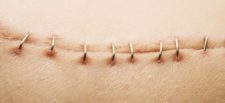Is Fast Wound Healing a Myth?
It may seem to you that fast wound healing is a myth on par with the Easter Bunny- everyone has heard of it but no one has actually seen it! This is understandable if you have been bogged down in chronic wounds that take forever to heal, frustrating both you and your client.
Circumstances for Wound Healing Quickly
The truth is that many wounds do heal quickly, given the right set of circumstances.
What are these circumstances?
- Surgical wounds tend to heal faster than non-surgical wounds because the edges of the wound are even and are approximated with sutures or staples. Even wounds that are left open to heal by secondary intention may heal more quickly than non-intentional wounds because wound location and depth are controlled by the surgeon.
- The right wound dressing will allow moist wound healing but will also absorb excess moisture, preventing maceration. Choosing the right dressing is the key to fast wound healing. Choosing the wrong dressing will delay healing if the wound bed is too moist or not moist enough- a proper balance must be struck between the two
- Recognition and prompt treatment of infection is perhaps one of the biggest factors in delayed wound healing. For fast wound healing to take place, practitioners must be vigilant in regards to infection and intervene in a timely manner when infection is suspected.
- Timely debridement of eschar and necrotic tissue can keep a wound on the fast track to healing. Wounds that have necrotic tissue present and are not debrided will certainly stall in the healing process.
- Control of blood glucose levels in diabetics is another key factor in wound healing. Blood sugar that is tightly controlled can do much to increase the prospect of fast wound healing. On the other hand, poorly controlled diabetes will increase the risk of infection and will delay wound healing at the cellular level.
- Good collaboration between practitioner and client can make a huge difference in fast wound healing. Clinicians who have built a trusting relationship with their client are far more likely to have their wound care instructions followed. A client who is engaged in the healing process is far more likely to follow instructions, particularly when they begin to see positive changes in their wound.
By keeping all of these factors in mind, you can prove the existence of fast wound healing. Want to learn more about wound care? Are you interested in becoming wound care certified? WoundEducators.com has what you need to take your career to the next level.


Hi Ms. Swezey.I like all the articles you send me. I traduce them in spanish for my students. I will like to know is there a manual for wound,skin and burns medications and treatment? If it’s exist how can I obtain a sample? Thank you very much. God blessyou.
Sincerely, Margarita Gonzalez
Thanks for this lovely post. Your expertise in this field is helpful for reference about wound care as I am in the same field..